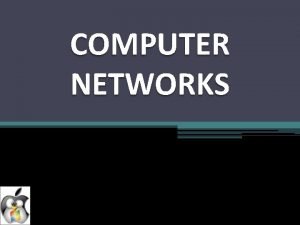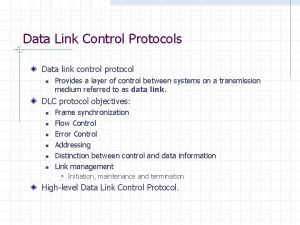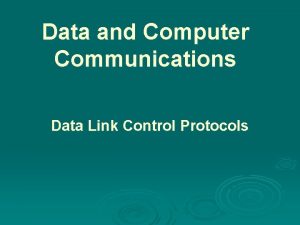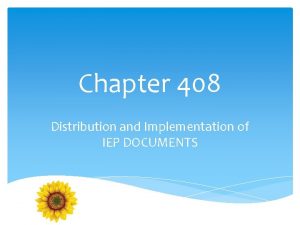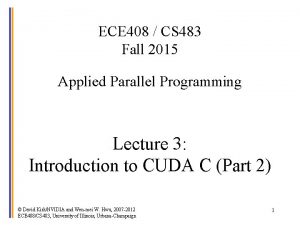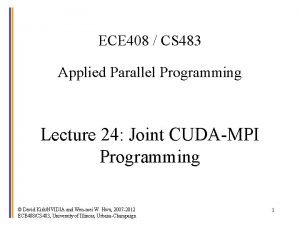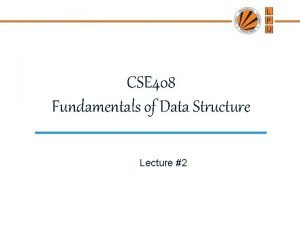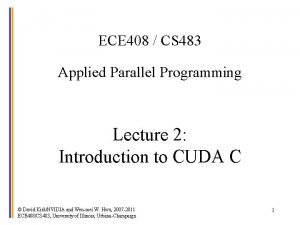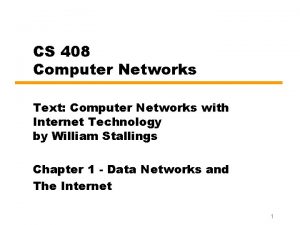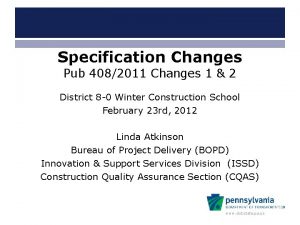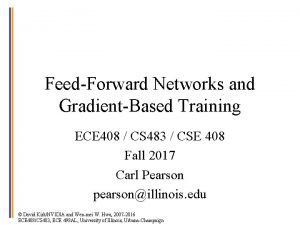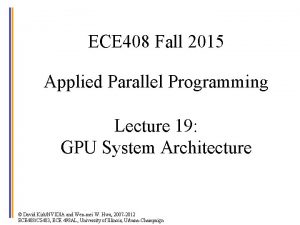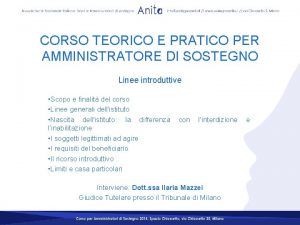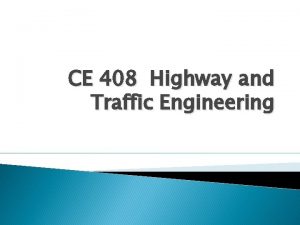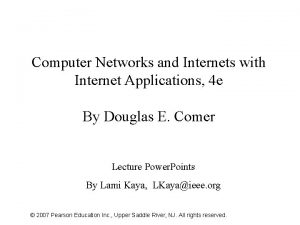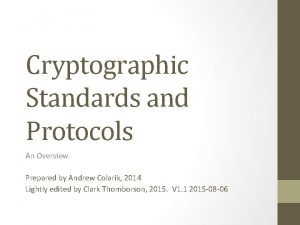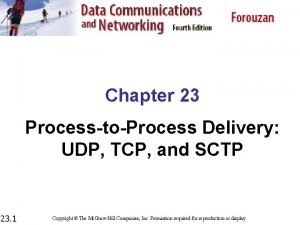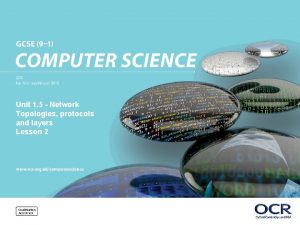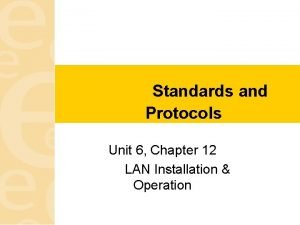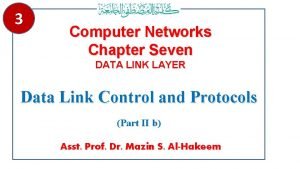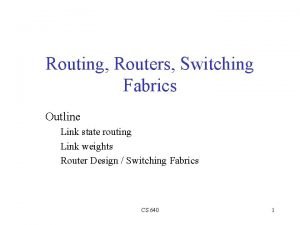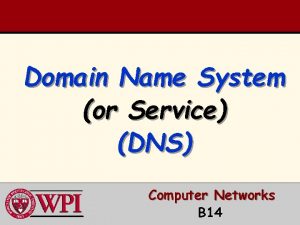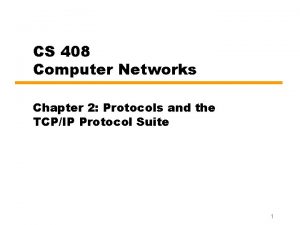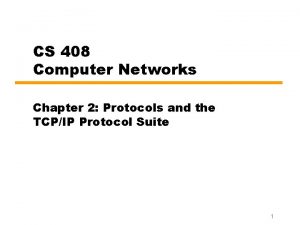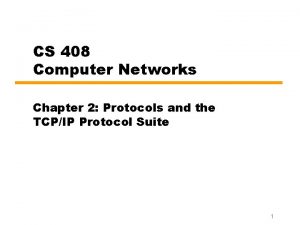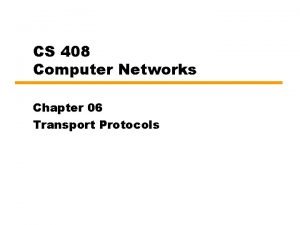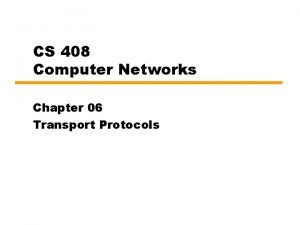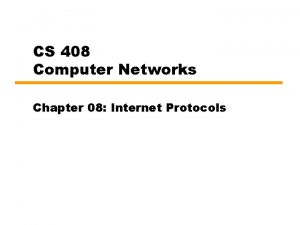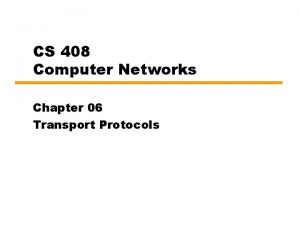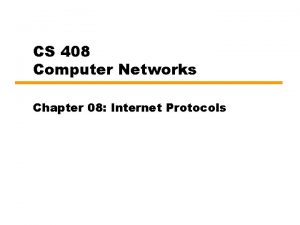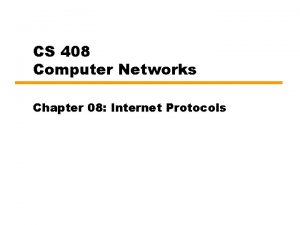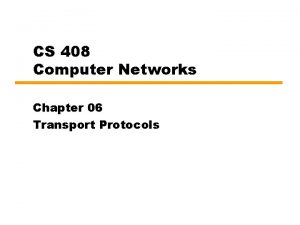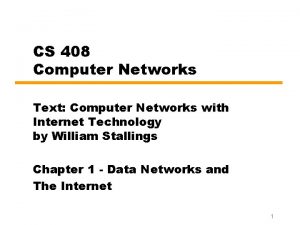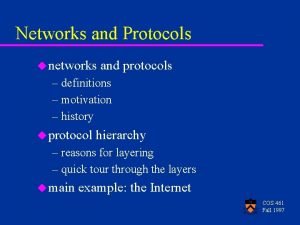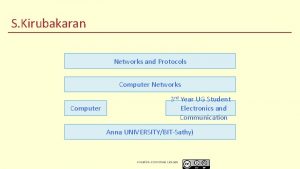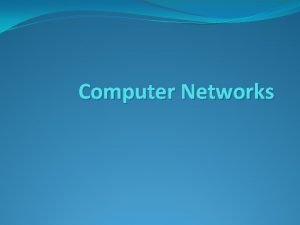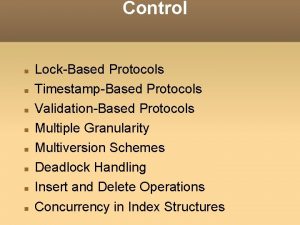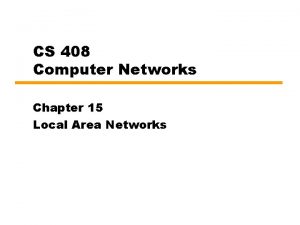CS 408 Computer Networks Chapter 2 Protocols and




























































- Slides: 60

CS 408 Computer Networks Chapter 2: Protocols and the TCP/IP Protocol Suite 1

Protocols • Cooperative action is necessary — computer networking is not only to exchange bytes — huge system with several utilities and functions. For examples • • error detection Encryption Routing etc. • For proper communication, entities in different systems must speak the same language — there must be mutually acceptable conventions and rules about the content, timing and underlying mechanisms • Those conventions and associated rules are referred as “PROTOCOLS” 2

Protocol Architecture • Task of data transfer is broken up into some modules —Why? —How do these modules interact? • For example, file transfer could use three modules —File transfer application —Communication service module —Network access module 3

A Real World Example to Protocol Architecture philosopher-translator-secretary architecture Issues: • peer-to-peer protocols are independent of each other —for example, secretaries may change the comm. medium to email —or the translators may agree on using another common language • Each layer adds a header 4

Simplified File Transfer Architecture File Transfer Application Layer: Application specific commands, passwords and the actual file(s) – high level data Communications Service Module: reliable transfer of those data – error detection, ordered delivery of data packets, etc. Network Module: actual transfer of data and dealing with the network – if the network changes, only this module is affected, not the whole system 5

General protocol architecture principles that we have seen so far • Layered structure —Protocol stack • Each layer provides services to upper layer; expect services from lower one —Layer interfaces should be well-defined • Peer entities communicate using their own protocol —peer-to-peer protocols —independent of protocols at other layers —if one protocol changes, other protocols should not get affected 6

A General Three Layer Model • Generalize the previous example for a generic application — we can have different applications (e-mail, file transfer, …) • Network Access Layer • Transport Layer • Application Layer 7

Network Access Layer • Exchange of data between the computer and the network • Sending computer provides address of destination — so that network can route • Different switching and networking techniques — Circuit switching — Packet switching — LANs — etc. • This layer may need specific drivers and interface equipment depending on type of network used. • But upper layers do not see these details — independence property 8

Transport Layer • Reliable data exchange — to make sure that all the data packets arrived in the same order in which they are sent out —Packets nor received in error are retransmitted • Independent of network being used • Independent of application 9

Application Layer • Support for different user applications • e. g. e-mail, file transfer 10

Addressing Requirements • Two levels of addressing required • Each computer needs unique network address • Each application on a (multi-tasking) computer needs a unique address within the computer — The service access point or SAP — The port number in TCP/IP protocol stack 11

Protocol Architectures and Networks or ports 12

Protocol Data Units (PDU) • User data is passed from layer to layer • Control information is added/removed to/from user data at each layer —Header (and sometimes trailer) —each layer has a different header/trailer • Data + header + trailer = PDU (Protocol Data Unit) —This is basically what we call packet —each layer has a different PDU 13

Transport PDU • Transport layer may fragment user data • Each fragment has a transport header added —Destination port —Sequence number • since the transport layer may split application data into smaller packets —Error detection code (generally at trailer) 14

Network PDU • Adds network header —network address for destination computer —optional facilities from network (e. g. priority level) 15

Operation of a Protocol Architecture Transport Header Network Header (Network PDU) 16

Standard Protocol Architectures • Common set of conventions • Nonstandard vs. standard protocols —Nonstandard: K sources and L receivers lead to K*L different protocols —If common protocol used, we design only once • Products from different vendors interoperate —Customers do not stick to a specific vendor —If a common standard is not implemented in a product, then that product’s market is limited; customers like standard products 17

Standard Protocol Architectures • Two approaches (standard) —OSI Reference model • never used widely • but well known —TCP/IP protocol suite • Most widely used • Another approach (proprietary) —IBM’s Systems Network Architecture (SNA) 18

OSI Reference Model • Open Systems Interconnection (OSI) • Reference model —provides a general framework for standardization —defines a set of layers and services provided by each layer —one or more protocols can be developed for each layer • Developed by the International Organization for Standardization (ISO) —also published by ITU-T (International Telecommunications Union) 19

OSI Reference Model • A layered model —Seven layers – seven has been presented as the optimal number of layer • Delivered too late (published in 1984)! —by that time TCP/IP started to become the de facto standard • Although no OSI-based protocol survived, the model is still valid (in the textbooks) —For Data Link Layer (that we will see later) OSI protocols are still valid 20

OSI - The Layer Model • Each layer performs a subset of the required communication functions • Each layer relies on the next lower layer to perform more primitive functions • Each layer provides services to the next higher layer • Changes in one layer should not require changes in other layers 21

OSI as Framework for Standardization layer functionalities are described by ISO; different standards can be developed based on these functionalities 22

Layer Specific Standards 23

Elements of Standardization • Protocol specification —Operates between the same layer on two systems • May involve different platforms —Protocol specification must be precise • Format of data units • Semantics of all fields • Service definition —Functional description of what is provided to the next upper layer • Addressing —Referenced by SAPs 24

The OSI Environment 25

OSI Layers (1) • Physical —Physical interface between devices —Characteristics • Mechanical - interface specs • Electrical - voltage levels for bits, transmission rate, coding, etc. • Data Link —Basic services: error detection and control, flow control at the link level (point to point) • Higher layers may assume error free transmission —Later a sublayer is added to Data Link Layer • MAC (Medium Access Control) sublayer • to deal with broadcast networks 26

OSI Layers (2) • Network —Transfer of information through communication network • network related issues —Network nodes (relays/routers) should perform switching and routing functions —Qo. S (Quality of Service) and congestion control are also addressed in this layer —Several other internetworking issues • e. g. differences in addressing, max. data length, etc. —Higher layers do not need to know about underlying networking technology —Not needed on direct links 27

Use of a Relay/Router 28

OSI Layers (3) • Transport —End to end exchange of data —In sequence, no losses, no duplicates —If needed, upper layer data are split into smaller units • Session —Control of dialogues • whose turn to talk? • Dialogue discipline (full-duplex, half-duplex) —Checkpointing and recovery 29

OSI Layers (4) • Presentation —Data formats —Data compression —Encryption • Application —Support for various applications 30

TCP/IP Protocol Suite • Most widely used interoperable network protocol architecture • Specified and extensively used before OSI —OSI was slow to take place in the market • Funded by the US Defense Advanced Research Project Agency (DARPA) for its packet switched network (ARPANET) —Do. D (Department of Defense) automatically created an enormous market for TCP/IP • Used by the Internet and WWW 31

TCP/IP Protocol Suite • TCP/IP does not have an official layer structure • But protocols imply one — Application layer — Transport (host to host / end to end) layer — Internet layer — Network access layer — Physical layer • Actually TCP/IP reference model has been built on its protocols — That is why that reference model is only for TCP/IP protocol suite — and this is why it is not so important to assign roles to each layer in TCP/IP; understanding TCP, IP and the application protocols would be enough 32

OSI vs. TCP/IP HTTP, SMTP, … TCP, UDP IP 33

Network Access and Physical Layers • TCP/IP reference model does not discuss these layers too much —the node should connect to the network with a protocol such that it can send IP packets —this protocol is not defined by TCP/IP —mostly in hardware —a well known example is Ethernet 34

Internet Layer • Connectionless, point to point internetworking protocol (uses the datagram approach) —takes care of routing across multiple networks —each packet travels in the network independently of each other • they may not arrive (if there is a problem in the network) • they may arrive out of order —a design decision enforced by Do. D to make the system more flexible and responsive to loss of some subnet devices • Implemented in end systems and routers as the Internet Protocol (IP) 35

Transport Layer • End-to-end data transfer • Transmission Control Protocol (TCP) —connection oriented —reliable delivery of data —ordering of delivery • User Datagram Protocol (UDP) —connectionless service —delivery is not guaranteed • Can you give example applications that use TCP and UDP? 36

Application Layer • Support for user applications • A separate module for each different application —e. g. HTTP, SMTP, telnet 37

IP (Internet Protocol) • The core of the TCP/IP protocol suite • Two versions co-exist — v 4 – the widely used IP protocol — v 6 – has been standardized in 1996, but still not widely deployed • IP (v 4) header minimum 20 octets (160 bits) 38

IPv 6 • IPv 6 —Enhancements over IPv 4 for modern high speed networks —Support for multimedia data streams • But the driving force behind v 6 was to increase address space — 128 -bit as compared to 32 -bit of v 4 • Not backward compatible —all equipment and software must change 39

TCP • Transmission Control Protocol —end to end protocol —Reliable connection = provides flow and error control • In TCP terms, a connection is a temporary association between entities in different systems • TCP PDU —Called “TCP segment” —Includes source and destination port • Identify respective users (applications) • pair of ports (together with the IP addresses) uniquely identify a connection; such an identification is necessary in order TCP to track segments between entities. 40

TCP Header 41

UDP • User Datagram Protocol • Alternative to TCP — end-to-end protocol • • Not guaranteed delivery No preservation of sequence No protection against duplication Minimum overhead 42

PDUs in TCP/IP Dest. Port Sequence number Checksum …. Dest. Address Source address …. Dest. Network Address Priority info 43

Operation of TCP and IP 44

Some Protocols in TCP/IP Suite 45

Internetworking • Interconnected set of networks —May be seemed as a large network • Each constituent network is a subnetwork • Entire configuration referred to as an internet —not the Internet • conceptually the same, but by “internet” we do not mean a specific network • the Internet is the most important example of an internet 46

Internetworking Devices • Each subnetwork supports communication among the devices attached to that subnetwork —End systems (ESs) • Subnetworks connected by intermediate systems (ISs) —In practice, ISs are routers that are used to relay and route packets between different subnetworks —If subnetworks use different Network Access Protocols, router should support all of the protocols —In OSI terminology, a router works at layer 3 (network layer) 47

Routers • Interconnect dissimilar subnetworks without any modifications on architecture of subnetworks • Must accommodate differences among networks, such as — Addressing schemes • network addresses may need to be translated — Maximum packet sizes • if two subnetworks have different limits for max. packet sizes, then router may need fragment/reassemble the packets • We have seen that subnetworks may have different network access and physical layers, but they have to speak the same (inter)network protocol implemented in all end systems and routers — The most important internetwork protocol is the IP protocol 48

Configuration for TCP/IP Example WAN 49

Action of Sender 50

Action of Router 51

Action of Receiver 52

Standards • Required to allow for interoperability among equipments • Advantages —Ensures a large market for equipment and software —Allows products from different vendors to communicate • Disadvantage —Freeze technology (? ? ? ) 53

Standards Organizations in Networking • Internet Society • ISO (International Organization for Standardization) —more formal —NGO, but most members are from governments • ITU-T (formerly CCITT) —International Telecommunications Union —UN agency —governmental 54

Internet Society (ISOC) • Internet development and standardization • 3 suborganizations —IAB (Internet Architecture Board) • overall Internet architecture —IETF (Internet Engineering Task Force) • protocol engineering and development —IESG (Internet Engineering Steering Group) • monitors IETF standardization efforts 55

IETF Organization • Grouped in areas —e. g. applications, security, routing, etc. —each area has an Area Director, who is also member of IESG • Each area has several working groups —working groups actually contribute to standards/protocols, etc. • Voluntary participation in IETF working groups • For detail see —www. ietf. org or —RFC 3160 - The Tao of IETF - A Novice's Guide to the Internet Engineering Task Force 56

Internet Drafts and RFCs • Internet Draft — Draft and temporary documents — expires in 6 months, if IESG does not approve it as an RFC — can be resubmitted — published online — comments are welcome • RFC (Request for Comments) — final version — can obsolete previous RFCs about the same topic — actually an RFC can be of any type of document • not necessarily a standard • Best Current Practice, Experimental, Informational RFCs • April 1 st RFCs (http: //en. wikipedia. org/wiki/April_1_RFC ) – My favorite is IP over Avian Carriers (RFC 1149) 57

58

Internet Standards Track • Steps involve increasing amount of scrutiny and testing • Step 1: Internet Draft • Step 2: Proposed standard — Internet Draft approved as an RFC by IESG — must remain at least six months to advance • Step 3: Draft standard — at least two independent and interoperable implementations — must remain at least 4 months • Step 4: Internet standard — Significant operational experience • key difference between ISOC and other standardization organizations — Consensus needed 59

Internet Assigned Numbers Authority (IANA) • An ISOC entity responsible for all “unique numbers” on the Internet —including IP addresses • Almost all protocols work with numeric parameters —e. g. port numbers, error codes, status codes, message types, options, etc. —the meanings of all numeric codes are mostly specified in RFCs, but number assignment is formalized by IANA 60
 Protocols and standards in computer networks
Protocols and standards in computer networks Elementary data link protocols in computer networks
Elementary data link protocols in computer networks Elementary data link protocols in computer networks
Elementary data link protocols in computer networks High level data link control protocol
High level data link control protocol Flow control protocols in data link layer
Flow control protocols in data link layer Difference between datagram and virtual circuit network
Difference between datagram and virtual circuit network Backbone networks in computer networks
Backbone networks in computer networks Chapter 408 pdf
Chapter 408 pdf Ece 408 uiuc
Ece 408 uiuc Ece 408
Ece 408 Cse 408
Cse 408 408(b)2
408(b)2 Usace section 408
Usace section 408 Ece 408
Ece 408 Cs 408 sabancı
Cs 408 sabancı Pub 408
Pub 408 Ece 408
Ece 408 Ece 408
Ece 408 Art 408 cc
Art 408 cc Ce 408
Ce 408 Chapter 3 network protocols and communications
Chapter 3 network protocols and communications Intserv vs diffserv
Intserv vs diffserv Error detection in computer networks
Error detection in computer networks Byte stuffing and bit stuffing
Byte stuffing and bit stuffing Character stuffing example
Character stuffing example Arp rarp protocol
Arp rarp protocol Analogue and digital transmission in computer networks
Analogue and digital transmission in computer networks Web and http in computer networks
Web and http in computer networks Computer networks and internets with internet applications
Computer networks and internets with internet applications Hamming distance in computer network
Hamming distance in computer network Error detection computer networks
Error detection computer networks Computer networks and internets
Computer networks and internets Proofs of work and bread pudding protocols
Proofs of work and bread pudding protocols Introduction to wan technologies
Introduction to wan technologies Cryptography standards and protocols
Cryptography standards and protocols Tcp and sctp are both layer protocols
Tcp and sctp are both layer protocols 5 network topologies
5 network topologies Snmp port number
Snmp port number Lan standards and protocols
Lan standards and protocols Lab 4-1: routing concepts and protocols
Lab 4-1: routing concepts and protocols Data link layer protocols for noisy and noiseless channels
Data link layer protocols for noisy and noiseless channels Routing fabric
Routing fabric 325181028 routing
325181028 routing Inter vlan routing layer 3 switch
Inter vlan routing layer 3 switch Plc norms and protocols
Plc norms and protocols Crc in computer networks
Crc in computer networks Crc in computer networks
Crc in computer networks Traffic management in computer networks
Traffic management in computer networks Tanenbaum
Tanenbaum What is optimality principle in computer networks
What is optimality principle in computer networks Snmp supports which formatted protocol
Snmp supports which formatted protocol What is optimality principle in computer networks
What is optimality principle in computer networks Business applications in computer networks
Business applications in computer networks Classify computer networks based of transmission technology
Classify computer networks based of transmission technology Intro dns
Intro dns Icmp in computer networks
Icmp in computer networks Framing in computer network
Framing in computer network Dns in computer networks
Dns in computer networks Data communication assignment
Data communication assignment Distributed system in computer network
Distributed system in computer network Computer networks routing algorithms
Computer networks routing algorithms


